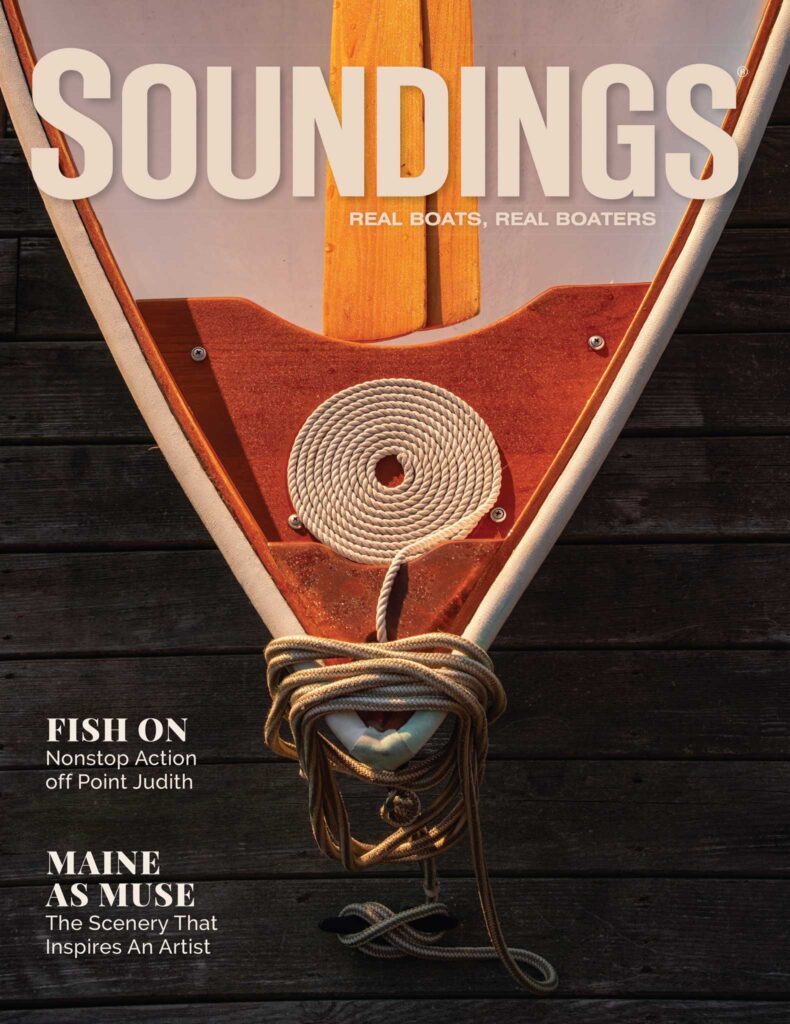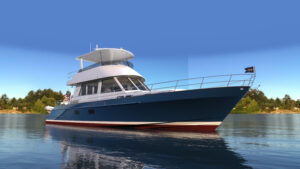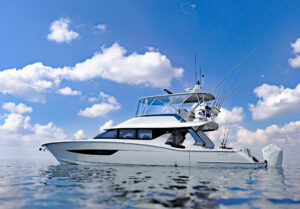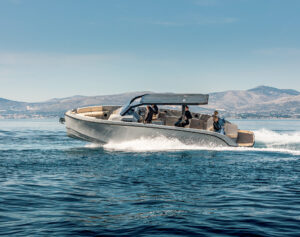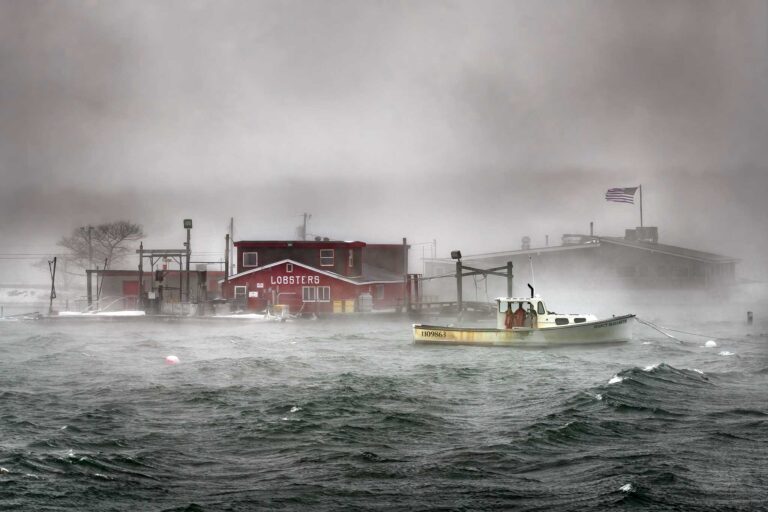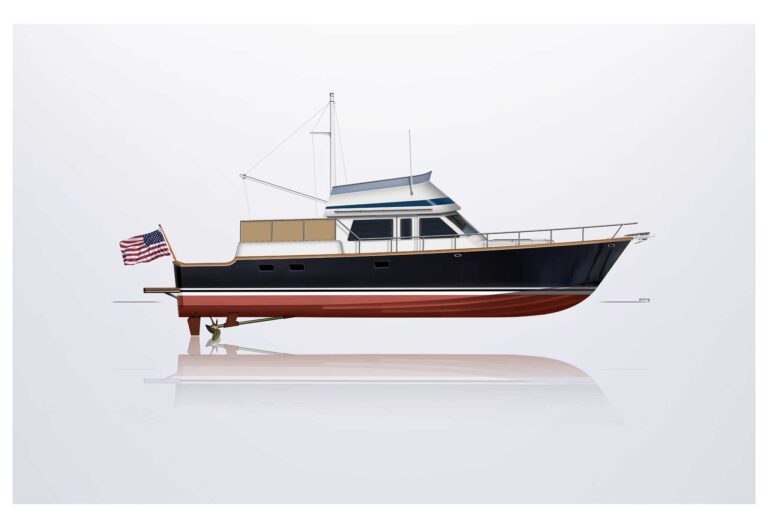
When Alexandra and Bill Clary met some 10 years ago, their shared love of boating drew them together. Both had grown up racing sailboats—Alexandra in British Columbia and Bill in Scituate, Massachusetts.
“We’re both lifelong sailors,” Alexandra says. “My parents took me aboard their small sailboat when I was one month old. I started racing competitively when I was 12, worked toward joining Team Canada in the Olympics in 470s, but university got in the way. Over the years, I’ve done a lot of big-boat racing, and some fun distance racing like the Vic-Maui [Victoria to Maui sailboat race]. I also owned several cruising and racing sailboats. Bill and I actually met racing aboard the same J-105 more than 10 years ago at a regatta in Toronto.” They married in 2020.
Bill grew up in the seaside town of Scituate, between Boston Harbor and Cape Cod Bay. He was hooked on sailing the day he jumped into a small boat that was part of a town sailing
program. “Neither of my parents were boaters, but they joined the local yacht club and my opportunities to sail expanded,” Bill said. “I started sailing on bigger boats around age 13, in the mid-1980s when PHRF was king, with 50 to 60 boats on the line every Wednesday night.”
After high school, he entered the Massachusetts Maritime Academy to study marine engineering. After graduation, he learned to build custom boats with Mark Lindsay (who went on to become one of the founders of Boston Boat Works) in Gloucester and Eric Goetz (well known for his advanced composites work) in Bristol, Rhode Island. Bill’s work has taken him to the West Coast and to Toronto, and he’s competed in numerous North American and World Championship regattas.
“When we settled in Annapolis, we started toying with the idea of going just a little farther and a little faster than we do in sailboats,” Bill says. “Actually, I had been sending pictures of desirable powerboat designs to Alexandra for about two years.”

“I told Bill that I could cross to the dark side if the boat was an especially ‘darling’ boat,” Alexandra says. “We’re talking about that adjective for the boat’s new name.”
Bill was always attracted to New England designs with working boat heritage. In his search, he came across Silver Heels, a Wasque 32 with a hardtop and lots of upgrades that was located in Connecticut. But he never made a connection with the owner. Alexandra searched online and, even though she knew nothing about the Wasque make and history, she located Cherokee, which was built in 1973. As it turns out, this Wasque was the personal boat of David Thompson, the founder of Vineyard Yachts and the designer of this 32. The couple made two trips to Florida to sea trial and survey the boat, then put it on a truck headed for their homeport of Annapolis, Maryland.
Previous owners had repowered the boat, and replaced the fuel and water tanks. “We’re upgrading the older electronics, replacing the soft goods inside and out, and adding new canvas,” Bill says. “Cherokee was much loved and well cared for by all the previous owners, and we intend to continue that work. We’ll update the hull in 2022 by repainting the topsides with the same color or clear-coating, and redoing the brightwork.”
The 200-hp Volvo Penta TAMD engine only had 450 hours when the couple took ownership. The boat, which carries 90 gallons of fuel in two tanks, burns around 2.5 gph at cruise and 8 gph at WOT. “The engine is a turbo diesel designed to run around 3600 rpm, and cruise at 12 to 13 knots. I think the boat is underpropped, though. I’ve heard from other Wasque 32 owners that it should do 15 to 16 cruise and 19 WOT,” says Bill.
The Clarys have used the boat extensively for day and evening cruises since taking possession of Cherokee. “We only live 10 minutes away from the slip, so we go to the boat pretty often,” Alexandra said. “And Bill has this thing: Every cruise either starts or ends in Ego Alley, which is a narrow but passable cut off Annapolis Harbor that takes boaters into the heart of downtown. Those dining or drinking at one or more of the waterside establishments are always appreciative, and occasionally, we get hailed by friends or just those who are curious about the builder of the boat.”
The couple is excited about planning a two-week cruise in July 2022, up the coast and through Long Island Sound to the boat’s original Massachusetts cruising grounds and beyond to Marblehead before returning to Annapolis.
WALKTHROUGH
In 1969 Martha’s Vineyard Angler David Thompson launched his dream fishing boat: a 32-footer with a cabin that was built of fiberglass—a relatively new material at the time. It was based on the lobster boat hulls of Maine designer Jarvis Newman, only tweaked for the local waters. It was named after Wasque Point, one of Thompson’s favorite Vineyard fishing grounds. Approximately 80 boats were completed over the course of the boat’s life span.
Riding a traditional displacement hull with a 10-foot beam, the boat had a shore-hugging draft of less than 2 feet. Standard power was a 280-hp diesel, which gave the boat a 17-knot top end.
All were based on a lobster boat style that was popular around Martha’s Vineyard. The basic boat rode on a traditional displacement hull with a 10-foot beam and was available in several configurations, with power options that ranged from a 160-hp Perkins diesel to a 330-hp Chrysler V-8 gasoline inboard. Thompson’s boat was configured as a New England bass boat.
Important characteristics of the Wasque 32 include a deep spoon bow and plenty of reserve buoyancy forward; a near-full-length keel with a shoe to protect the prop and rudder; and a springy, graceful sheer that holds the eye. The cockpit is large and secure, with a hinged engine box that provides seating.
Every Wasque 32 is different, as layouts were customized for individual owners. On Cherokee, the cabin is two steps down from the cockpit. A compact galley is to port, and an enclosed head is to starboard. Twin facing bench seats are aft of a large V-berth. Teak ceiling strips play nicely against white surfaces for a classic, Downeast look. A large overhead hatch and brass side ports make for plenty of natural light and ventilation.
Specifications
LOA: 32’0”
Beam: 10’0”
Draft: 3’0”
Displ.: 10,000 lbs.
Power: (1) 200-hp Volvo Penta TAMD P-A
If you are shopping for a pre-owned boat, you can begin a search at Boatquest.com, operated by Active Interest Media, parent company of Soundings.
This article was originally published in the March 2022 issue.

